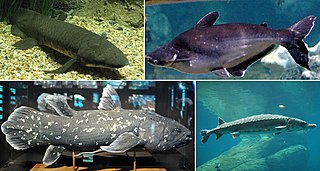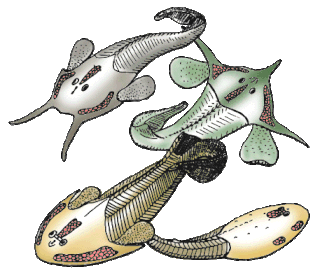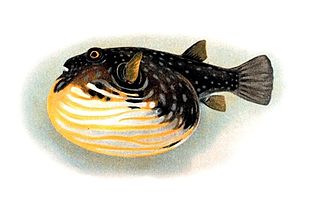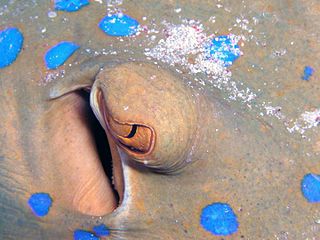
Chondrichthyes is a class of jawed fish that contains the cartilaginous fish or chondrichthyans, which all have skeletons primarily composed of cartilage. They can be contrasted with the Osteichthyes or bony fish, which have skeletons primarily composed of bone tissue. Chondrichthyes are aquatic vertebrates with paired fins, paired nares, placoid scales, conus arteriosus in the heart, and a lack of opercula and swim bladders. Within the infraphylum Gnathostomata, cartilaginous fishes are distinct from all other jawed vertebrates.

Osteichthyes, also known as osteichthyans or commonly referred to as the bony fish, is a diverse superclass of vertebrate animals that have endoskeletons primarily composed of bone tissue. They can be contrasted with the Chondrichthyes and the extinct placoderms and acanthodians, which have endoskeletons primarily composed of cartilage. The vast majority of extant fish are members of Osteichthyes, being an extremely diverse and abundant group consisting of 45 orders, over 435 families and 28,000 species. It is the largest class of vertebrates in existence today, encompassing most aquatic vertebrates, as well as all semi-aquatic and terrestrial vertebrates.

A gill is a respiratory organ that many aquatic organisms use to extract dissolved oxygen from water and to excrete carbon dioxide. The gills of some species, such as hermit crabs, have adapted to allow respiration on land provided they are kept moist. The microscopic structure of a gill presents a large surface area to the external environment. Branchia is the zoologists' name for gills.

Sharks are a group of elasmobranch fish characterized by a cartilaginous skeleton, five to seven gill slits on the sides of the head, and pectoral fins that are not fused to the head. Modern sharks are classified within the clade Selachimorpha and are the sister group to the Batoidea. Some sources extend the term "shark" as an informal category including extinct members of Chondrichthyes with a shark-like morphology, such as hybodonts. Shark-like chondrichthyans such as Cladoselache and Doliodus first appeared in the Devonian Period, though some fossilized chondrichthyan-like scales are as old as the Late Ordovician. The earliest confirmed modern sharks (selachimorphs) are known from the Early Jurassic around 200 million years ago, with the oldest known member being Agaleus, though records of true sharks may extend back as far as the Permian.

Stingrays are a group of sea rays, a type of cartilaginous fish. They are classified in the suborder Myliobatoidei of the order Myliobatiformes and consist of eight families: Hexatrygonidae, Plesiobatidae, Urolophidae (stingarees), Urotrygonidae, Dasyatidae, Potamotrygonidae, Gymnuridae and Myliobatidae . There are about 220 known stingray species organized into 29 genera.

Fish anatomy is the study of the form or morphology of fish. It can be contrasted with fish physiology, which is the study of how the component parts of fish function together in the living fish. In practice, fish anatomy and fish physiology complement each other, the former dealing with the structure of a fish, its organs or component parts and how they are put together, such as might be observed on the dissecting table or under the microscope, and the latter dealing with how those components function together in living fish.

Aquatic respiration is the process whereby an aquatic organism exchanges respiratory gases with water, obtaining oxygen from oxygen dissolved in water and excreting carbon dioxide and some other metabolic waste products into the water.

Ostracoderms are the armored jawless fish of the Paleozoic Era. The term does not often appear in classifications today because it is paraphyletic and thus does not correspond to one evolutionary lineage. However, the term is still used as an informal way of loosely grouping together the armored jawless fishes.

Rajiformes is one of the four orders in the clade Batomorphi, often referred to as the superorder Batoidea, flattened cartilaginous fishes related to sharks. Rajiforms are distinguished by the presence of greatly enlarged pectoral fins, which reach as far forward as the sides of the head, with a generally flattened body. The undulatory pectoral fin motion diagnostic to this taxon is known as rajiform locomotion. The eyes and spiracles are located on the upper surface of the head and the gill slits are on the underside of the body. Most species give birth to live young, although some lay eggs enclosed in a horny capsule.

The operculum is a series of bones found in bony fish and chimaeras that serves as a facial support structure and a protective covering for the gills; it is also used for respiration and feeding.
This glossary of ichthyology is a list of definitions of terms and concepts used in ichthyology, the study of fishes.

Shark anatomy differs from that of bony fish in a variety of ways. Variation observed within shark anatomy is a potential result of speciation and habitat variation.

Marine vertebrates are vertebrates that live in marine environments, which include saltwater fish and marine tetrapods. As a subphylum of chordates, all vertebrates have evolved a vertebral column (backbone) based around the embryonic notochord, forming the core structural support of an internal skeleton, and also serves to enclose and protect the spinal cord.

Branchial arches or gill arches are a series of paired bony/cartilaginous "loops" behind the throat of fish, which support the fish gills. As chordates, all vertebrate embryos develop pharyngeal arches, though the eventual fate of these arches varies between taxa. In all jawed fish (gnathostomes), the first arch pair develops into the jaw, the second gill arches develop into the hyomandibular complex, and the remaining posterior arches support the gills. In tetrapods, a mostly terrestrial clade evolved from lobe-finned fish, many pharyngeal arch elements are lost, including the gill arches. In amphibians and reptiles, only the oral jaws and a hyoid apparatus remains, and in mammals and birds the hyoid is simplified further to support the tongue and floor of the mouth. In mammals, the first and second pharyngeal arches also give rise to the auditory ossicles.
The following outline is provided as an overview of and topical guide to fish:

Most bony fishes have two sets of jaws made mainly of bone. The primary oral jaws open and close the mouth, and a second set of pharyngeal jaws are positioned at the back of the throat. The oral jaws are used to capture and manipulate prey by biting and crushing. The pharyngeal jaws, so-called because they are positioned within the pharynx, are used to further process the food and move it from the mouth to the stomach.

The evolution of fish began about 530 million years ago during the Cambrian explosion. It was during this time that the early chordates developed the skull and the vertebral column, leading to the first craniates and vertebrates. The first fish lineages belong to the Agnatha, or jawless fish. Early examples include Haikouichthys. During the late Cambrian, eel-like jawless fish called the conodonts, and small mostly armoured fish known as ostracoderms, first appeared. Most jawless fish are now extinct; but the extant lampreys may approximate ancient pre-jawed fish. Lampreys belong to the Cyclostomata, which includes the extant hagfish, and this group may have split early on from other agnathans.

Fish gills are organs that allow fish to breathe underwater. Most fish exchange gases like oxygen and carbon dioxide using gills that are protected under gill covers (operculum) on both sides of the pharynx (throat). Gills are tissues that are like short threads, protein structures called filaments. These filaments have many functions including the transfer of ions and water, as well as the exchange of oxygen, carbon dioxide, acids and ammonia. Each filament contains a capillary network that provides a large surface area for exchanging oxygen and carbon dioxide.

Fish physiology is the scientific study of how the component parts of fish function together in the living fish. It can be contrasted with fish anatomy, which is the study of the form or morphology of fishes. In practice, fish anatomy and physiology complement each other, the former dealing with the structure of a fish, its organs or component parts and how they are put together, such as might be observed on the dissecting table or under the microscope, and the latter dealing with how those components function together in the living fish.

Spiracles are openings on the surface of some animals, which usually lead to respiratory systems.



















